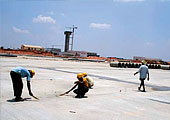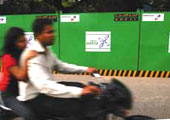11:30 A.M., May 4, 2007
 |
| Insidious roads: While vehicle
population has exploded in the city, roads continue to be
narrow and congested. But a Metro rail service (see inset)
may help ease traffic |
Mahatma
Gandhi Boulevard is the main arterial road in Bangalore where
the city's denizens like to saunter. Flanked by the Parade Ground
on the one side and a bustling commercial centre on the other,
mg Road is where Bangalore happens. A couple of weeks ago, massive
diggers with giant claws crawled out onto mg Road, biting off
chunks of road. After hanging fire for nearly a decade, work had
begun on the Rs 6,207-crore Bangalore Metro project. While there
was a tinge of regret in the air over the fact that a city landmark
would forever change, there was a greater sense of hope. "All
the digging might mean additional temporary inconvenience, but
we will gladly put up with it if it means that eventually I get
to spend more time with my family rather than on the road,"
says Ratna Rajgopal, a software engineer who works out of sap's
facility in Whitefield, a city suburb.
She speaks for every other Bangalorean. While
the infotech and biotech boom did put India's Garden City on the
global map, it also put tremendous pressure on its infrastructure.
Bangalore's population, for instance, nearly doubled in the last
decade to top 7 million. Unable to cope with this influx, made
worse by an apathetic state administration, the city's infrastructure
collapsed. Power and water shortages became the norm rather than
the exception. The city requires 35 million units a day of electricity,
but the best that the utilities can do is 27 million units. Demand
for water is estimated at 1,200 million litres per day (LPD),
but the supply is around 750 million LPD. It is a little-known
fact, but after Mexico city, Bangalore is the only other major
city in the world that is farthest away from its water source.
Water from the Cauvery has to be piped over 120 km into the city.
No wonder, the idea of sharing the river water with neighbouring
Tamil Nadu raises the hackles of Kannadigas.
Even as the utilities began to creak, the
city's roads were running out of space. The two-wheeler population
in Bangalore is the second highest in India after Delhi, and some
1,000 new vehicles pour onto the city roads every day. The apology
of an airport that India's Silicon Valley sports, has been bursting
at the seams, with passenger traffic growing 44 per cent last
year alone. Every day, airplanes routinely hover over the airport
for as much as half an hour due to congestion. To make things
worse, about two years ago, the local police began forcing all
shopping establishments to close by 11.30 p.m. A city once famous
for its numerous pubs and night life was no longer the same.
So, when a shaky coalition government took
charge 16 months ago replacing another equally shaky one, little
was expected. Benign neglect was the best hope, unlike a couple
of the earlier governments that were seen to be actively working
against the city's interests. But surprisingly enough, there have
been signs of improvement over the last couple of months, thanks
in one part to the government and the other part to activist citizens.
Work on the Metro has started, even as tenders have been invited
for a monorail system to act as a feeder service. The new Bangalore
international airport coming up at Devanahalli seems to be on
track for the first flight to take off in April 2008.
 |
Devanahalli: Readying for
take-off |
 |
| Soon, they could be riding the
Metro |
The formation of Bruhat Bangalore (Greater
Bangalore), along the lines of Bruhan Mumbai, seems to be paying
off as well. Integration of seven surrounding civic municipal
areas, including Rajarajeshwari Nagar, Dasarahalli, Bommanhalli,
Krishnarajapuram, Mahadevapura, Bytrayanpura, and Yelhanka (apart
from one town council, Kengeri, and 111 villages) means that the
city's size has grown from 225 to 741 square kilometres. This
should lead to a more planned development of Bangalore, besides
which it will augment its resources in the long run. While earlier
the government was shooing away investment to other parts of the
state saying that availability of land and other resources was
a constraint, the formation of 'Greater Bangalore' has freed up
nearly 20,000 hectares of land for industrial use.
If there was one symbol that indicated Bangalore's
inability to make any progress on infrastructure, it was the half-done
flyover that greeted visitors as soon as they came out of the
city airport. But guess what? Four years after its launch and
several crores of rupees in cost overruns, the flyover opened
to traffic five months ago. Similarly, several other near-abandoned
flyovers, which had begun to look like grotesque sculptures of
steel and cement, have been finished. K. Jairaj, Commissioner
of Bruhat Bangalore Mahanagar Palike, says that work on expanding
eight key arterial roads at a cost of Rs 67 crore has begun. The
Bangalore Development Authority, which plays a key role in developing
the city's infrastructure, has taken up work on peripheral ring
roads to connect far-flung areas. Says Chief Minister H.D. Kumaraswamy:
"The coalition government is committed to improving infrastructure
in Bangalore in a time-bound manner. Formation of Greater Bangalore,
launch of work on Metro rail, widening of key arterial roads in
the city and the new international airport will solve a number
of problems."
Even as the Chief Minister uttered those
confident words, 280 trucks carrying 2,300 tonnes of garbage had
formed a smelly queue on the city's roads. Why? The city's dumping
grounds were full up. Fresh garbage collection came to a standstill,
until a fresh dumping site on the outskirts of the city was identified.
Bangalore is optimistic, but not too much.
|







